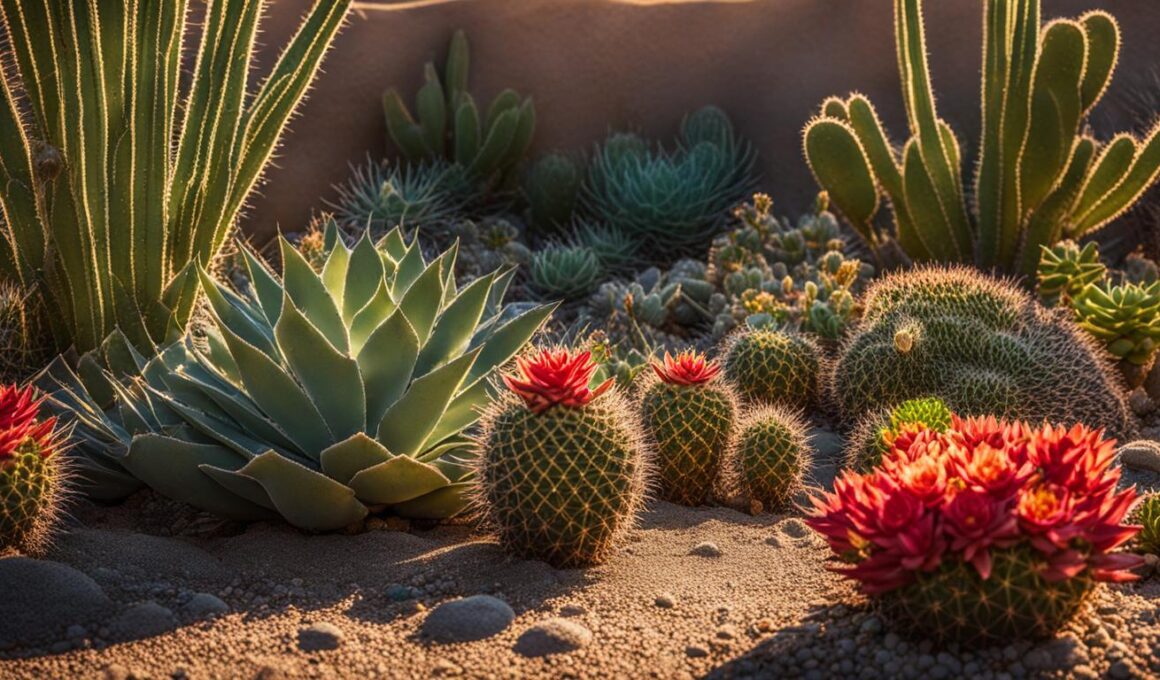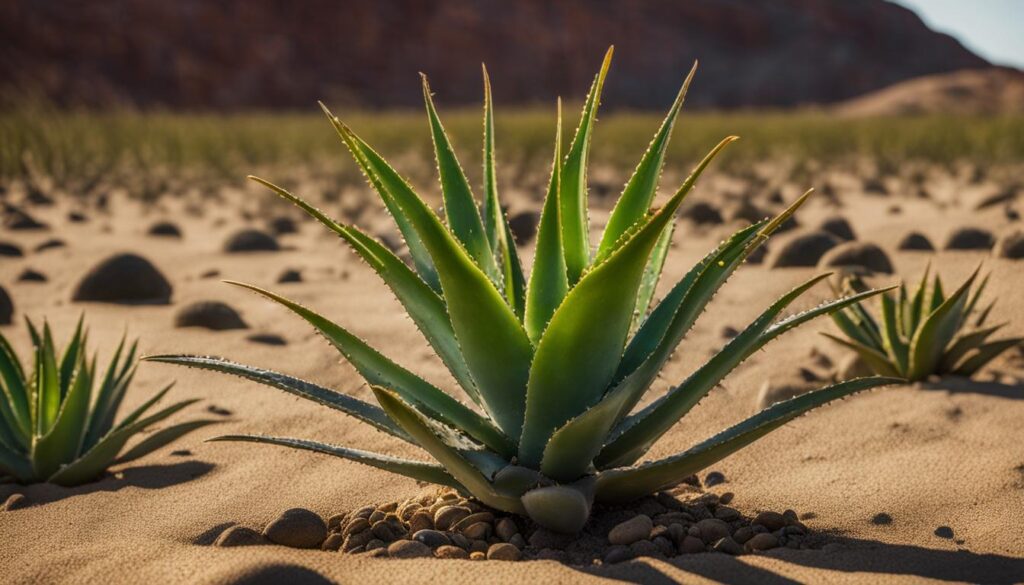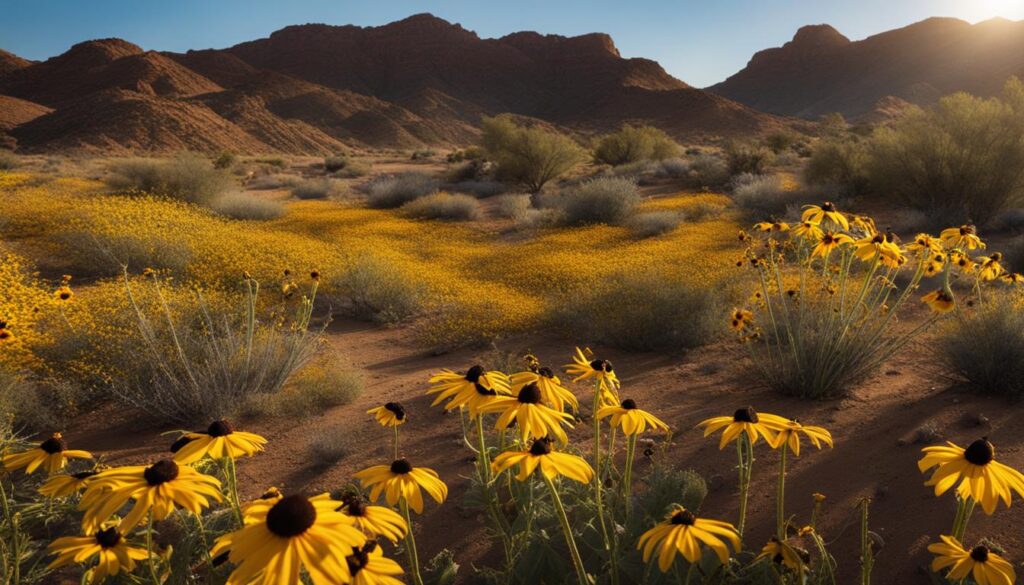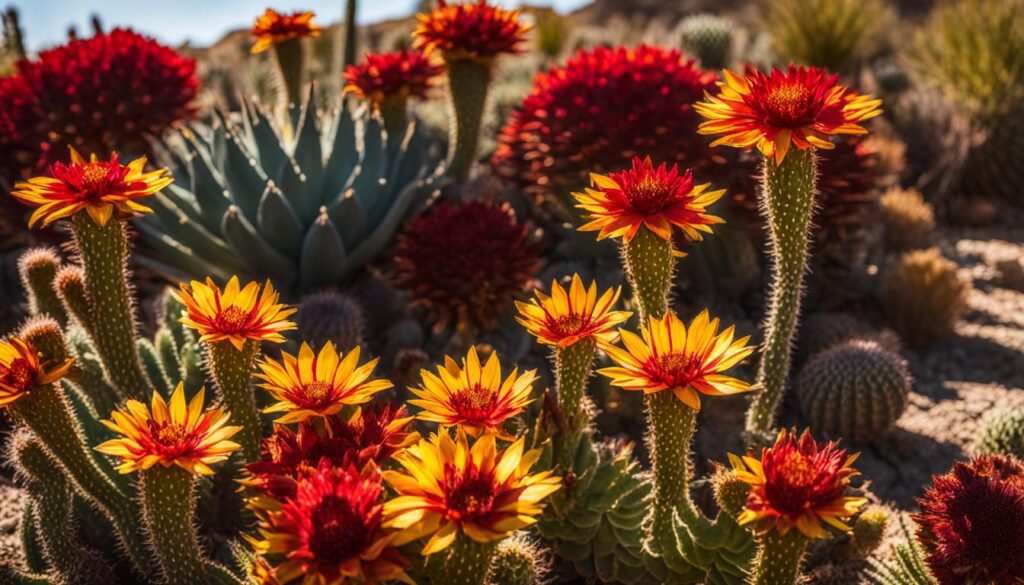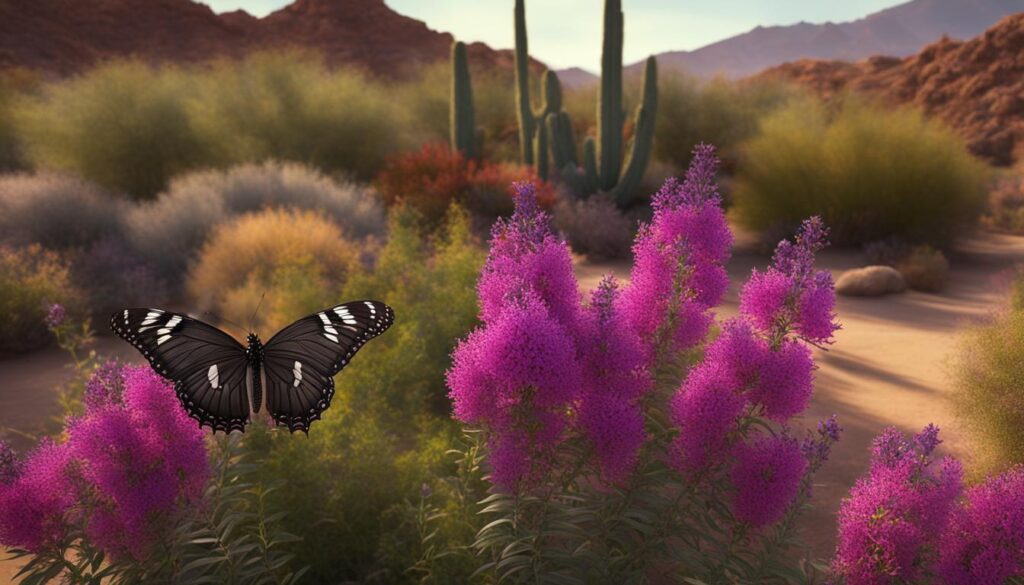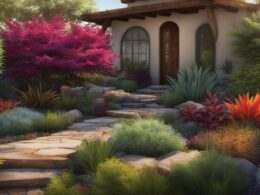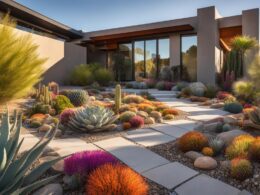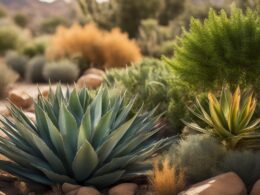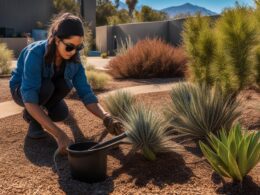Scorching temperatures can threaten to dry out plants in desert gardens, but choosing low water plants can help them thrive even in the heat. These drought-tolerant species can withstand limited rainfall and create a blooming oasis in arid landscapes.
Key Takeaways:
- Low water plants are essential for thriving in arid desert gardens.
- These drought-tolerant species can withstand limited rainfall and high temperatures.
- Low water plants add beauty and color to the landscape.
- Proper care and watering during the establishment phase are crucial for their success.
- Choose from a variety of low water plants for different preferences and needs.
Aloe Vera (Aloe barbadensis miller)
Aloe vera is a popular choice for desert gardens due to its ability to thrive in low water conditions. This drought-resistant succulent is well-suited to the arid landscape and sandy soil found in desert regions. Its bright green succulent leaves store water, allowing the plant to survive on minimal watering.
Aloe vera is a versatile plant that not only adds aesthetic appeal to a desert garden but also offers medicinal benefits. Its gel-like substance is commonly used to treat burns, cuts, and other skin irritations. With its hardiness and usefulness, aloe vera is a valuable addition to any arid landscape.
Growing Aloe Vera in Desert Gardens
When planting aloe vera in a desert garden, it’s important to provide well-draining soil to prevent waterlogging. Sandy soil is ideal for aloe vera as it allows excess water to drain away quickly, mimicking its natural habitat. This succulent thrives in full sun but can tolerate partial shade as well.
- Choose a location with plenty of sunlight.
- Prepare the soil by adding sand or gravel to improve drainage.
- Water the plant sparingly, allowing the soil to dry out between waterings.
- Fertilize with a balanced, low-nitrogen fertilizer once a year during the growing season.
Aloe vera is a resilient plant that requires minimal maintenance once established. Regularly remove any dead or dry leaves to keep the plant looking its best. With proper care and attention, aloe vera will thrive and add beauty to your desert garden.
Table: Aloe Vera Care Guide
| Aspect | Conditions |
|---|---|
| Sunlight | Full sun, partial shade |
| Soil | Sandy, well-draining |
| Watering | Sparingly, allowing soil to dry out between waterings |
| Fertilizer | Low-nitrogen, once a year during growing season |
Angelonia (Angelonia angustifolia)
Angelonia, also known as Angelonia angustifolia, is a tropical native that thrives in desert gardens. This low water plant is specifically adapted to the hot and arid conditions of desert landscapes. With its vibrant and showy spikes of blue, purple, pink, or white blossoms, angelonia adds a splash of color and beauty to any garden.
To ensure the successful growth of angelonia in your garden, it is important to provide it with the right conditions. This plant thrives in full sun, so make sure it receives ample sunlight throughout the day. Additionally, angelonia requires well-draining soil to prevent waterlogging and promote healthy root growth.
One of the great benefits of angelonia is its ability to bloom all summer long, even in high temperatures. However, it is important to note that angelonia is commonly grown as an annual plant. In certain USDA cold hardiness zones, it may be possible for angelonia to survive as a perennial.
Angelonia Care Tips:
- Plant angelonia in full sun for optimal growth and blooming.
- Ensure the soil is well-draining to prevent waterlogging.
- Water angelonia regularly during its establishment phase, but be careful not to overwater.
- Deadhead faded flowers to promote continuous blooming.
- Consider using angelonia in containers, hanging baskets, or border plantings for a stunning display.
In summary, angelonia is a tropical native that thrives in desert gardens. With its vibrant and showy blossoms, this low water plant brings color and beauty to arid landscapes. By providing it with full sun and well-draining soil, you can enjoy its stunning blooms all summer long.
Black-Eyed Susans (Rudbeckia hirta)
Black-Eyed Susans, scientifically known as Rudbeckia hirta, are versatile and resilient low water plants that are perfect for desert gardens. With their vibrant orange-red petals and purplish-black cones, they add a burst of color to any landscape. These plants thrive in arid environments and can tolerate clay soil, making them an excellent choice for gardens with less than ideal soil conditions.
One of the standout features of Black-Eyed Susans is their reblooming capability. With proper care and cutting, they can produce a late-season bloom, extending their beauty well into the fall. This characteristic makes them a valuable addition to any garden, as they continue to brighten up the landscape when other plants may be fading.
Aside from their attractive appearance and resilience, Black-Eyed Susans are also known for their deer-resistant properties. This makes them an ideal choice for gardens located in areas frequented by deer. With Black-Eyed Susans, you can enjoy their beauty without having to worry about deer damaging your plants.
The Benefits of Black-Eyed Susans:
- Drought-tolerant and suitable for arid environments.
- Can thrive in clay soil conditions.
- Reblooming capability for extended beauty.
- Deer-resistant properties for worry-free gardening.
In summary, Black-Eyed Susans are a fantastic choice for desert gardens due to their ability to thrive in low water conditions and clay soil. Their striking colors and reblooming capability make them stand out, while their deer-resistant properties provide peace of mind for gardeners. So, consider adding these beautiful and resilient plants to your desert garden for a vibrant and low-maintenance landscape.
Gaillardia (Gaillardia pulchella)
Gaillardia, also known as Gaillardia pulchella, is an excellent choice for low water gardens, especially those with sandy or well-draining soil. These beautiful blanket flowers are not only drought-tolerant but also add vibrant color to the landscape with their warm-toned daisy-like blooms in shades of yellow, orange, and red.
One of the reasons Gaillardia thrives in sandy soil is its ability to tolerate dry conditions. Sandy soil drains quickly, preventing excess moisture from accumulating around the plant’s roots, which can cause root rot. Additionally, Gaillardia’s deep root system allows it to access water deeper in the soil, providing some resilience during periods of drought.
Another advantage of Gaillardia is its ability to spread or “blanket” an area with its flowers. This makes it a great choice for filling in empty spaces, creating a colorful carpet of blooms. Gaillardia is a perennial plant, meaning it will come back year after year, providing long-lasting beauty in the garden.
When planting Gaillardia, it is essential to ensure the soil is well-draining to prevent waterlogged conditions. Adding organic matter, such as compost, can improve soil structure and drainage. Gaillardia thrives in full sun but can tolerate some shade, although it may result in reduced flowering.
Table: Summary of Gaillardia
| Common Name | Gaillardia |
|---|---|
| Scientific Name | Gaillardia pulchella |
| Soil Type | Sandy soil, well-draining soil |
| Water Requirements | Low water, drought-tolerant |
| Bloom Colors | Yellow, orange, red |
| Growth Habit | Perennial, spreading |
With its ability to thrive in low water conditions, its stunning blooms, and its ability to spread and fill in spaces, Gaillardia is a perfect choice for sandy or well-draining soil in desert gardens. Consider adding Gaillardia to your landscape to create a beautiful and vibrant oasis in even the most arid environments.
Butterfly Bush: A Fast-Growing Flowering Shrub for Clay Soil
If you’re looking for a low water plant that thrives in clay soil, the butterfly bush (Buddleja davidii) is an excellent choice. This fast-growing flowering shrub is not only drought-resistant but also adds a delightful burst of color to your garden. With its spiky blooms and ability to attract butterflies, the butterfly bush is a favorite among gardeners.
The butterfly bush is well-suited for clay soil, which can be challenging for many other plants. Its deep roots can penetrate the heavy soil, allowing it to thrive even in less-than-ideal conditions. This makes it a great option for gardens with clay soil or areas where water retention is a concern.
One of the standout features of the butterfly bush is its rapid growth. In just a few years, it can reach heights of 6 to 12 feet, making it an ideal choice for creating privacy or adding vertical interest to your garden. With proper pruning, you can encourage bushier growth, which will lead to more abundant blooms.
Benefits of Butterfly Bush in Your Garden
Aside from its attractive appearance, the butterfly bush offers several benefits to your garden ecosystem. As its name suggests, this shrub attracts butterflies with its sweet nectar-rich flowers. These vibrant blooms also draw other pollinators like bees and hummingbirds, helping to enhance the overall biodiversity of your garden.
The butterfly bush is a fast-growing, flowering shrub that adds a burst of color to any garden.
In addition, the butterfly bush is low maintenance, requiring minimal care once established. It thrives in full sun and can tolerate a wide range of soil conditions, including clay soil. As a result, it is an excellent choice for busy gardeners or those who want a beautiful yet low-effort addition to their landscape.
Summary
- The butterfly bush is a fast-growing flowering shrub that thrives in clay soil.
- Its vibrant blooms attract butterflies, bees, and hummingbirds, enhancing biodiversity.
- This low maintenance plant is well-suited for busy gardeners or those looking for a colorful addition to their landscape.
| Plant | Soil Type | Growth Rate | Bloom Color |
|---|---|---|---|
| Butterfly Bush | Clay soil | Fast-growing | Varies (purple, pink, white) |
Catmint (Nepeta cataria)
If you’re looking for a low-water plant that can thrive in desert gardens, consider catmint. Also known as Nepeta cataria, catmint is a fragrant plant that can tolerate low-water conditions once established. It’s a great choice for arid landscapes and can add a touch of beauty to your garden.
Catmint produces pretty purple flowers that attract butterflies and bees, making it a pollinator-friendly plant. Its beautiful blooms and its ability to tolerate drought make it a popular choice for low-maintenance gardening. Whether you’re planting it as an edging plant or letting it spread, catmint can create an eye-catching display of color in your garden.
One important factor to keep in mind when growing catmint is the soil type. For optimal growth, catmint requires well-draining soil. This helps prevent water from pooling around the roots, which can lead to root rot. Make sure to choose a spot in your garden with well-draining soil to ensure the success of your catmint plants.
Overall, catmint is a wonderful addition to any low-water garden. Its fragrance, beautiful flowers, and ability to tolerate drought make it a favorite among gardeners. Consider adding catmint to your desert garden and enjoy the sights and scents it brings.
| Plant | Water Requirements | Soil Type | Special Features |
|---|---|---|---|
| Catmint (Nepeta cataria) | Low-water conditions once established | Well-draining soil | Fragrant purple flowers, attracts butterflies and bees |
Chaste Tree (Vitex agnus-castus)
The Chaste Tree, scientifically known as Vitex agnus-castus, is a beautiful and drought-tolerant plant that can thrive in desert gardens with loose soil. This low water plant produces stunning summer blooms, adding vibrant colors to the landscape. With its graceful appearance and ability to withstand arid conditions, the Chaste Tree is a popular choice for those seeking a resilient and visually appealing addition to their garden.
In addition to its ornamental value, the Chaste Tree is known for attracting pollinators such as butterflies and bees. This makes it a fantastic option for those who want to create a pollinator-friendly environment. The tree’s fragrant flowers and nectar-rich blooms provide a valuable food source for these beneficial insects, helping to support local ecosystems.
When planting a Chaste Tree, it’s important to ensure that the soil is well-draining and loose. This allows for proper water penetration and helps prevent waterlogged conditions, which can be detrimental to the tree’s health. To encourage prolific flowering, deadheading the spent blooms in late winter is recommended. This practice helps redirect the plant’s energy towards producing new blooms, ensuring a stunning display of color during the summer months.
Potential Benefits of Chaste Tree
“The Chaste Tree is not only visually appealing but also offers potential medicinal benefits. Its berries have been used for centuries as a natural remedy for menstrual and hormonal imbalances. While more research is needed, some studies suggest that Chaste Tree extracts may help alleviate symptoms associated with PMS and menopause. As with any herbal remedy, it is important to consult with a healthcare professional before using.”
With its ability to thrive in desert environments and its stunning summer blooms, the Chaste Tree is a wonderful addition to any low water garden. Its resilience, aesthetic appeal, and potential medicinal benefits make it a versatile and valuable choice for garden enthusiasts. Whether you’re looking to attract butterflies, create a vibrant landscape, or explore herbal remedies, the Chaste Tree is sure to delight and inspire.
| Key Features | Details |
|---|---|
| Type | Deciduous shrub |
| Height | Average height of 10-20 feet |
| Exposure | Full sun |
| Soil | Well-draining, loose soil |
| Watering | Tolerates drought conditions once established |
| Blooms | Produces purple summertime blooms |
| Attracts | Butterflies and bees |
| Additional Benefits | Potential medicinal uses |
Coneflower (Echinacea purpurea)
Coneflower, scientifically known as Echinacea purpurea, is a popular choice for low water gardens due to its ability to thrive in heat and tolerate drought conditions. These heat-tolerant plants are a great addition to desert gardens, offering vibrant and long-lasting blooms. Coneflowers are also deer-resistant, making them an ideal choice for areas with wildlife.
Coneflowers prefer rich soil that is well-draining, ensuring that excess water does not pool around the roots. It is important to plant them in an area with good drainage to prevent root rot. These hardy perennials can withstand hot and dry climates, making them low maintenance and suitable for gardeners looking to conserve water.
With their stunning display of colorful flowers, coneflowers are a focal point in any garden. From the classic purple coneflower to variations in shades of pink, white, and yellow, there is a wide variety to choose from. Their cone-shaped centers also provide an interesting focal point and attract pollinators, such as bees and butterflies, to your garden.
| Bloom Color | Height | Spacing | Sun Exposure | Bloom Time |
|---|---|---|---|---|
| Purple | 2-4 feet | 18-24 inches | Full sun to part shade | Summer to fall |
| Pink | 2-4 feet | 18-24 inches | Full sun to part shade | Summer to fall |
| White | 2-4 feet | 18-24 inches | Full sun to part shade | Summer to fall |
Whether you’re looking to add color to your desert garden or create a wildlife-friendly habitat, coneflowers are an excellent choice. Their ability to thrive in rich soil, tolerate heat, and resist deer make them a versatile and attractive addition to any low water garden.
Carnation (Dianthus caryophyllus)
When it comes to low water plants for desert gardens, carnations are a fantastic choice. These sprawling perennials are not only beautiful but also require minimal water to thrive. Known for their pretty flowers and mounding blue-green foliage, carnations add a touch of elegance to any garden.
Carnations are highly adaptable and can grow well in different soil types, including rich soil. This makes them suitable for a variety of garden settings. Whether your garden has sandy soil or clay soil, carnations can flourish with minimal care and maintenance. They are also deer-resistant, making them a great option for keeping unwanted visitors out of your garden.
With carnations, you can create stunning displays of color in your desert garden. These low water plants come in a wide range of hues, including pink, red, white, and bi-color varieties. Their jagged-edged petals add texture and visual interest to your landscape. Plant them along borders in sunny spots to enjoy their vibrant blooms throughout the year.
| Carnation Varieties | Color | Growth Habit |
|---|---|---|
| Chabaud | Mixed Colors | Double Blooms |
| Grenadin | Red | Compact |
| Malmaison | Pink | Frilly Blooms |
| Carnival | Bi-color | Uniquely Patterned |
With their drought-tolerant nature, beautiful flowers, and resistance to deer, carnations are a wonderful addition to any desert garden. These low water plants make it easy to create a stunning and sustainable landscape that thrives in arid conditions.
Conclusion
In conclusion, incorporating low water plants into your desert garden is vital for thriving in arid environments. These drought-tolerant species are specifically adapted to withstand limited rainfall and the scorching heat common in desert regions.
By choosing low water plants, you can create a vibrant and colorful oasis in your arid landscape. These plants not only add beauty to your garden but also require minimal water once established, making them ideal for water conservation efforts.
Remember to provide proper care and watering during the establishment phase to help these plants flourish. With their ability to thrive with minimal water, low water plants are the perfect choice for desert gardens, allowing you to enjoy a stunning and sustainable landscape.
FAQ
Are low water plants suitable for desert gardens?
Yes, low water plants are perfect for desert gardens as they can withstand limited rainfall and high temperatures.
What are some examples of low water plants?
Some examples of low water plants include aloe vera, angelonia, black-eyed susans, gaillardia, butterfly bush, catmint, chaste tree, coneflower, and carnation.
How do I take care of aloe vera plants in a desert garden?
Aloe vera plants are drought-resistant and can survive with minimal water. However, occasional watering can help prolong their lifespan. They also benefit from well-draining sandy soil.
Are black-eyed susans deer-resistant?
Yes, black-eyed susans are deer-resistant, making them a great choice for gardens where deer may be present.
What kind of soil does gaillardia prefer?
Gaillardia prefers sandy, well-draining soil. It can tolerate drought conditions and is known as a “blanket flower” due to its ability to spread and cover an area with beautiful blooms.
How can I attract butterflies to my garden?
Butterfly bushes, such as the fast-growing Buddleja davidii, are excellent for attracting butterflies. They produce masses of spiky blooms that butterflies love.
What type of soil does catmint need?
Catmint thrives in low-water conditions and prefers well-draining soil. It is also known for its fragrant purple flowers and its ability to attract butterflies and bees.
How can I promote flowering in chaste trees?
Deadheading the chaste trees in late winter can promote flowering in spring and summer. They also prefer loose soil and are drought-tolerant.
Are coneflowers heat-tolerant?
Yes, coneflowers, scientifically known as Echinacea purpurea, are heat-tolerant and can add vibrancy to gardens even during hot summer months. They are also deer-resistant.
Do carnations require rich soil?
Yes, carnations prefer rich soil and are known for their pretty flowers and mounding blue-green foliage. They can be planted along borders in sunny spots and are also deer-resistant.





